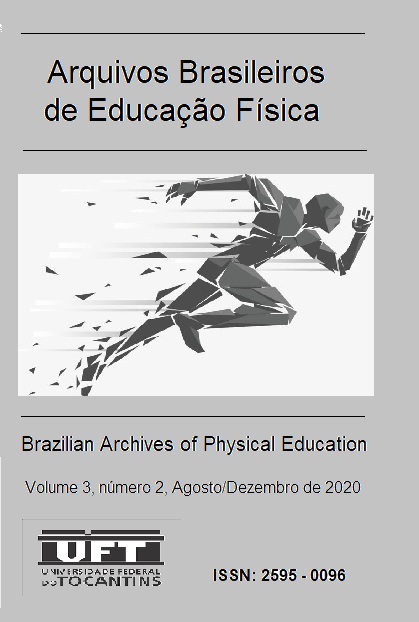Influence of physical exercise on the TCD4+ cell count in people living with HIV / AIDS: an integrative review
DOI:
https://doi.org/10.20873/10.20873/abef.2595-0096.v2n2p5055.2020Keywords:
Body Composition, Physical exercise, Retroviral therapyAbstract
Acquired Immunodeficiency Syndrome (AIDS) was a milestone in history, the HIV infection epidemic represents a global phenomenon. The main pharmacological tool is the High Intensity Antiretroviral Therapy (ART), which can generate some adverse effects among them the Lipodystrophy syndrome. Physical exercise has been presented as an alternative tool to reduce the adverse effects of pharmacological treatment. The bibliographic survey was carried out based on studies published in the PubMed database. Articles published from 1999 to 2018 were accessed, using the keywords contained in the abstracts: resistance training, lipodystrophy, HIV / AIDS. Thus, the aim of this study was to analyze the effects of strength training, aerobic and combined, on metabolic and anthropometric parameters. The combined exercise induced superior results in the immune system and in the improvement of the body composition in this population, in comparison to the strength and aerobic training.
References
Felipe LDJ, Navarro F. Os efeitos do exercício físico na resposta imune nos indivíduos infectados com HIV que utilizam o tratamento retroviral. Revista Brasileira de Prescrição e Fisiologia do Exercício. 2008;2(11):507–517.
Lazzarotto AR, Deresz LF, Sprinz E. HIV/AIDS e treinamento concorrente: a revisão sistemática Revista Brasileira de Medicina do Esporte. 2010;16(7):149–154.
Relatório Anual do Programa Conjunto das Nações Unidas sobre HIV/AIDS (UNAIDS). Acesso em 24/07/2018 as 21:45: <https://unaids.org.br/wp-content/uploads/2018/07/2018_07_17_Fact-Sheet_miles-to-go.pdf>.
Santos FF et al. Características imunológicas e virológicas e as variáveis flexibilidade e força de resistência abdominal de crianças e adolescentes portadores de HIV-AIDS em uso de TARV. Revista Brasileira de Medicina do Esporte. 2013;19(1):40–43.
Medeiros DC et al. Somatótipo e imagem corporal em pessoas vivendo com HIV/AIDS. Revista Brasileira de Medicina do Esporte. 2016;22(1):54–58.
Lazzarotto AR, Pereira BP, Harthmann AD, Bazzo KO, Vicenzi FL, Sprinz E. Treinamento físico no risco de doença isquêmica cardíaca em sujeitos HIV/AIDS em uso de TARV Revista Brasileira de Medicina do Esporte. 2014;20(3):233–236.
Domingo P et al. Subcutaneous adipocyte apoptosis in HIV-1 protease inhibitor-associated lipodystrophy. AIDS. 1999;13(16):2261-2267.
Melo BP et al. Respostas agudas do exercício físico em pessoas infectadas pelo HIV: uma revisão sistemática. Revista Brasileira Medicina do Esporte. 2017;23(2):152–159.
Silva C et al. Metabolic profile, anthropometric and lipodystrophy in people living with HIV / AIDS in antirretroviral therapy. Nutrición Clínica y Dietética Hospitalaria. 2016;36(3):38–44.
Cutrono SE, Lewis JE, Perry A, Signorile J, Tiozzo E, Jacobs KA et al. The Effect of a Community-Based Exercise Program on Inflammation, Metabolic Risk, and Fitness Levels Among Persons Living with HIV/AIDS. AIDS and Behavior. 2016;20(5):1123–1131.
Boop CM, Phillips KD, Fulk LJ, Dudgeon WD, Sowell R, Hand GA. Physical activity and immunity in HIV-infected individuals. AIDS Care. 2004;16(3):387–393.
Baigis J, Korniewicz DM, Chase G, Butz A, Jacobson D, Wu AW. Effectiveness of a home-based exercise inter- vention for HIV-infected adults: a randomized trial. J Assoc Nurses AIDS Care. 2002;13:33-45.
Downloads
Published
How to Cite
Issue
Section
License
Proposal for Copyright Notice Creative Commons
1. Policy Proposal to Open Access Journals
Authors who publish with this journal agree to the following terms:
A. Authors retain copyright and grant the journal right of first publication with the work simultaneously licensed under the Creative Commons Attribution License that allows sharing the work with recognition of its initial publication in this journal.
B. Authors are able to take on additional contracts separately, non-exclusive distribution of the version of the paper published in this journal (ex .: publish in an institutional repository or as a book), with an acknowledgment of its initial publication in this journal.
C. Authors are permitted and encouraged to post their work online (eg .: in institutional repositories or on their website) at any point before or during the editorial process, as it can lead to productive exchanges, as well as increase the impact and the citation of published work (See the Effect of Open Access).




